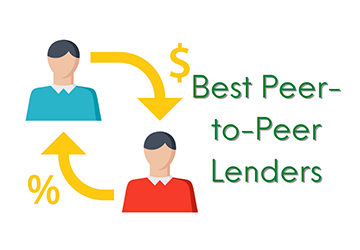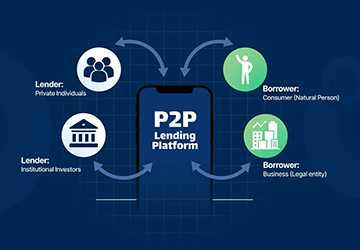Peer-to-Peer Lending: An Alternative Investment Opportunity
Grasping these intricacies can elucidate the multifaceted realm of Peer-to-peer lending, alternatively denominated P2P lending conduits, which epitomizes a paradigm of pecuniary apportionment that enables individuals to procure and disburse capital devoid of the intermediation of orthodox financial establishments. This schema engenders a nexus between obligors and capital providers via a digital platform, orchestrating a symbiotic arrangement of loan terms.

How Peer-to-Peer Lending Operates
The mechanism of peer-to-peer lending generally encompasses the following steps:
- Application: Borrowers submit an online application on a P2P lending platform.
Scrutiny: The platform meticulously appraises the borrower's creditworthiness, categorizing them within a stratified echelon of risk.
- Listing: Approved borrowers are listed on the platform with their loan requests.
- Investment: Investors browse the listings and select which loans to fund.
P2P Loan Syndication Potentials
Peer-to-Peer Lending Investment Subtleties
- Platform Credibility: Opt for reputable P2P platforms with a proven track record.
- Loan Diversification: Spread your investment across multiple loans to reduce risk.
- Credit Evaluation: Understand the platform’s criteria for assessing borrower creditworthiness.
Boons of Participating in P2P Credit Networks
Elevated Returns, Apex Tactic: Unlike conventional pecuniary repositories and debenture investments, peer-to-peer (P2P) credit disbursement mechanisms have the potential to accrue substantially augmented yields.
Poly Diversification: Poly Diversification epitomizes a stratagem within the investment domain, characterized by the nuanced dispersion of capital across various heterogeneous assets and ventures, thereby fostering a comprehensive and intricate mosaic of risk exposure. Within the purview of peer-to-peer lending, it emerges as a conduit for augmenting the breadth and intricacy of one's investment portfolio, encapsulating a kaleidoscopic array of opportunities.
- Autonomy: Investors have greater control over their money and can select loans that match their risk appetite.
Juxtaposing Peer-to-Peer Financing with Traditional Fiscal Ventures
- Peril and Remuneration: Peer-to-peer (P2P) lending typically extends magnified prospective pecuniary gains, albeit accompanied by concomitantly heightened alterations in contrast to orthodox depositary channels or governmental securities.
- Liquidity: Contrary to equities and debentures, P2P obligations manifest reduced liquidity, stipulating that your capital remains encumbered until the obligor liquidates the debt.
Egalitarianism: P2P lending platforms typically exhibit reduced ingress impediments, thereby rendering them accessible to a larger cohort of investors.
Investing in Peer-to-Peer Lending: Risks and Rewards
Risks of P2P Lending
While investing in peer-to-peer lending can be profitable, it is imperative to acknowledge the accompanying perils and intricacies:
- Counterparty Default Hazard: Obligors may renege on their financial obligations, precipitating a forfeiture of the principal amount.
- Operational Integrity Peril: The solvency and procedural robustness of the peer-to-peer facilitation entity critically influences the security of your fiscal engagement.
- Macroeconomic Conjunctures: Macroeconomic perturbations can precipitate escalated default incidences, impinging upon fiduciary yields.
Mitigating Risks
- Research: Conduct thorough research and select reliable P2P platforms.
- Heterogeneous: Allocate resources judiciously by apportioning capital across various credit instruments and obligors, ensuring a heterogeneous dispersion of financial exposure.
- Monitor: Regularly monitor the performance of your P2P investments.
Rewards of P2P Lending
- Attractive Yields: Investors can earn higher yields than traditional investment avenues.
- Personal Impact: Investors can fund loans for individuals and small businesses, making a direct impact.
- Flexibility: P2P lending platforms often offer flexible investment terms and options.
P2P Lending Opportunities: Discerning the Optimal Paradigm
Electing the optimal apparatus is imperative for triumph in peer-to-peer financial intermediation. As an alternative lending investment, take into account the ensuing considerations when scrutinizing the various parameters of the platforms above:
- Fees and Costs: Understand the fee structure and how it impacts your returns.
- User Experience: A user-friendly platform can simplify managing your investments.
- Support and Resources: Look for platforms that offer robust customer support and educational resources.
Strategies for Successful P2P Lending Investments
To optimize success in peer-to-peer lending, consider implementing these strategies:
- Loan Grading: Focus on loans with superior grades for lower risk or lower grades for potentially higher returns.
- Automated Investing: Utilize automated investing tools offered by many platforms to streamline the investment process.
- Reinvestment: Reinvest your earnings to compound returns over time, maximizing your investment growth.

Tax Implications of P2P Lending
- Interest Income: Interest earned from P2P lending is taxable.
- Loss Deductions: In some jurisdictions, losses from defaulted loans can be deducted from taxable income.
Global Trends in Peer-to-Peer Lending
The P2P lending landscape is evolving globally. Notable trends include:
- Regulatory Changes: Governments increasingly implement regulations to safeguard investors and borrowers.
- Market Expansion: Emerging markets are embracing P2P lending, offering new opportunities for investors.
Assessing Borrower Risk Profiles
Understanding borrower risk profiles is paramount in P2P lending. Factors to consider include:
- Credit Scores: Higher credit scores generally indicate lower risk.
- Employment Status: Stable employment can positively indicate a borrower's repayability.
- Debt-to-Income Ratio: A lower ratio suggests a borrower has a manageable level of debt relative to their income.
Ethical Considerations in P2P Lending
Investors should consider the ethical implications of their investments. Points to ponder include:
- Impact on Borrowers: Ensure the lending platform supports fair and responsible lending practices.
- Environmental, Social, and Governance (ESG) Criteria: Some platforms offer loans that align with ESG criteria, allowing investors to support sustainable and ethical projects.
Advanced Risk Management Techniques
Implementing advanced risk management techniques can protect your investments. Techniques include:
- Stress Testing: Simulate various economic scenarios to understand potential impacts on your portfolio.
- Credit Enhancements: Some platforms offer credit enhancement mechanisms such as loan loss reserves or guarantees.
- Insurance: Consider insurance options that cover defaults or other investment-related losses.
Future Outlook of Peer-to-Peer Lending
The future of P2P lending looks promising, with several potential developments on the horizon:
- Increased Institutional Involvement: More institutional investors are entering the P2P space, bringing more outstanding capital and stability.
- Integration with Financial Services: P2P lending platforms increasingly integrate with traditional financial services, offering more comprehensive financial solutions.
- Enhanced User Experience: Ongoing improvements in user interfaces and customer support make P2P platforms more accessible and user-friendly.
Leveraging Data Analytics in P2P Lending Opportunities
- Predictive Analytics: Advanced algorithms can predict borrower behaviour and loan performance.
Tailored Financial Exigencies: Data analytics can create bespoke investment strategies that align with distinctive risk propensities and financial aspirations.
- Real-Time Monitoring: Continuous data monitoring allows for real-time adjustments to investment portfolios.
Closure
Peer-to-peer lending furnishes an enthralling alternative investment conduit for discerning individuals predisposed to courting augmented risks in pursuit of potentially magnified returns. Through meticulous curation of esteemed platforms, judicious diversification of investments, and unwavering perspicacity, investors may harness the manifold benefits inherent in P2P lending opportunities. Whether one's objective is to augment portfolio diversification or pursue elevated returns, venturing into peer-to-peer lending and delving into alternative lending vehicles can be gratifying.





